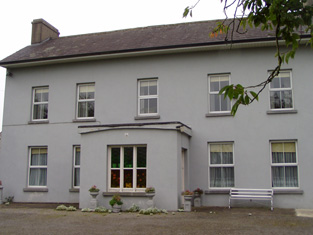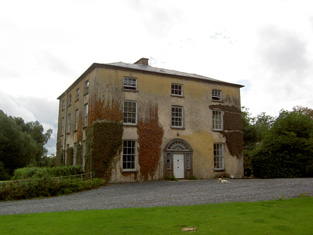Churchtown House
Houses within 5km of this house
Displaying 24 houses.
Houses within 5km of Churchtown House
Displaying 24 houses.
| House name | Description | |
|---|---|---|
| Dunbarry | This house was the home of James Carey in 1814. Occupied by James Heffernan and held from Sir Edward Tierney at the time of Griffith's Valuation, valued at £18. Sold by the Heffernans in the early 20th century, this house is still extant. The Irish Tourist Association survey mentions Dunbarry as the residence of Denis Kiely in the 1940s. | |
| Tullig | Tullig, located on the Tierney estate and valued at £15.15 shillings, was occupied by Richard Hutch in the early 1850s. The Irish Tourist Association Survey noted that it had belonged to Lord Broghill before the 1641 rebellion and was later granted to the Percevals. It was the residence of John Waterson in the 1940s. It is no longer occupied. |

|
| Gubleagh House | The buildings at Gubleagh House, Annagh South were valued at £13 at the time of Griffith's Valuation and the house was occupied by Johanna Cowhy who held it and 189 acres from Sir Edward Tierney. This house is still occupied. | |
| Burton Park | The original house built by Sir John Perceval and his descendants was burnt down in the Jacobite War 1689-1691. A late Georgian house was built to replace it by the [3rd or 4th] Earl of Egmont which was remodelled in the late 19th century. Burton Park was leased to the Purcells in the 19th century. It was occupied by the Reverend Matthew Purcell in 1814 and 1837 and by his son John in the early 1850s when the house was valued at £34. Passed to the Ryans of Scarteen, county Limerick by marriage in the early 20th century. In the 1940s the Irish Tourist Association Survey noted Burton Park as one of the best examples of eighteenth century domestic architecture in county Cork. Still the home of the Ryan Purcell family. |

|
| Clashganniv | Hajba writes that this house has always been the home of the O'Brien family. Vincent O'Brien, the famous Irish race horse trainer, was born at Clashganniv in 1917. The house is still extant and occupied. At the time of Griffith's Valuation there were two houses in Clashganniv, one valued at £16, was occupied by James Lynch and the other valued at £10 was held in fee by Sir Edward Tierney. | |
| Creggannacourty | Cregane House in Creggannacourty was occupied by the representatives of Sarah Barry and held from Sir Edward Tierney at the time of Griffith's Valuation, when the house was valued at £35. Hajba associates the names Crofts, Hennessy and Hutchins with the house, which in 2002 was the home of the Lynch family. |

|
| Mount Corbitt | Home of the Glover family in the first half of the 19th century. Hajba writes that the Glover's sold their lease to the Anderson family in the early 1850s. In the early 20th century it became the home of the O'Brien family and is still occupied. |

|
| Rath | Smith writes in 1750 that Rath was built by Alderman James French of Cork. Rath house was occupied by Michael Greene in the early 1850s and held from Sir Edward Tierney. It was valued at £12. To the north Rath Cottage (Grid Ref R492 147) was held by Sir Edward Tierney in fee and was valued at £14. This cottage is now a ruin and Rath House although still extant is no longer lived in, a new house having been built on the site. | |
| Walshestown | This townland was leased to Robert Conron early in the 18th century by Sir Philip Perceval. By 1814 the house was occupied by John Wrixon. Hajba writes that he was the son of Edward and Anne Wrixon. In the early 1850s Nicholas Wrixon was resident holding the house valued at £8 from John Wrixon. In the 1830s the house is recorded as being occupied by George Crofts and his wife Eliza Purcell of nearby Burton Park. George Crofts was a brother of the Reverend F.W. Crofts. This house is no longer occupied. |

|
| Jordanstown | A house valued at £14 was occupied at Jordanstown by James Buckley at the time of Griffith's Valuation and held from Sir Edward Tierney. Hajba writes that the Buckleys continued to live at Jordanstown for the rest of the 19th century. Sold to Patrick Walshe in the early 20th century this house is no longer occupied. |

|
| Liskelly | This house situated on the Egmont estate was occupied by Richard Gregg in 1814 and in the early 1850s by David Coghlan who held the house valued at £12 from Sir Edward Tierney. Later Liskelly became the residence of the Nagles and the Brownes. It is no longer occupied. | |
| Bregoge House | A house reputed to incorporate the remains of an old castle. Bregoge Castle was occupied by J. Rogers in 1837 and by John Rogers in the early 1850s. The property was held from the Earl of Egmont and the buildings were valued at £7. The Irish Tourist Association survey in the 1940s notes it as the residence of "Mr.Ryan, a commercial traveller". The house is still a family home. |

|
| Ardenville | A single storey house possibly built for the heir to the Egmont title, Baron Arden, to reside in before succeeding to the title. At the time of Griffith's Valuation it was occupied by James Norcott and valued at £11.10 shillings. Recently extended and still occupied. | |
| Egmont House | An early Perceval house situated at Egmont was replaced by the present house in the 18th century. At the time of Griffith's Valuation John Bolster was occupying Egmont House on the Egmont estate. The buildings were valued at £15. Later leased to the Lynch family. The house is extant and under refurbishment in recent years. |

|
| Egmont Lodge | A house was in existence at this location at the time of the first Ordnance Survey but is not named on the map. By the time of Griffith's Valuation it was valued at £14 and occupied by Bartholomew W. Purdon. It is labelled Egmont Lodge on the 25-inch Ordnance Survey map of the 1890s. A house is still extant at the site. |

|
| Egmont Cottage | Egmont Cottage is marked on the first Ordnance Survey map circa 1840. It was the single storied residence of Margaret Magrath in the early 1850s. She held the property from the Earl of Egmont and the buildings were valued at £10. The building has since been extended and is still occupied. Hajba calls this house Egmont Lodge. |

|
| Fort Moylan | Home of the Moylan family on the Egmont estate, occupied by Cornelius Moylan at the time of Griffith's Valuation when the buildings were valued at £10. Still extant and occupied |

|
| Velvetstown | Seat of the Crofts family for over three centuries, "Velvex-town" was occupied by Thomas Crofts in 1814, by T. Lucas Crofts in 1837 and by Reverend William Crofts in the early 1850s. Reverend William held the house and 708 acres from Penrose Fitzgerald and the buildings were valued at £21. Hajba writes that the original house was replaced by an elaborate Italianate mansion in the late 1870s but when this burnt down in 1895 they moved back into their old home. She also writes that Velvetstown is one of the few North Cork houses still occupied by the family that built it. The Irish Tourist Association survey noted in the 1940s that the walls of the Italianate mansion were still standing though the chimneys had been taken down. |

|
| Castle Wrixon | A Wrixon property in the 18th century, occupied by John Wrixon in 1814 and Hajba writes that it was sold by the Wrixons to the Crofts in the mid 19th century. At the time of Griffith's Valuation it was occupied by John Connor who held it from Wills G. Crofts. The buildings were valued at £11. Christopher Crofts of Velvetstown House (died 1913) lived at Castle Wrixon for a time. He inherited Velvetstown from his uncle, Reverend Henry, in 1869. In the 1940s the Irish Tourist Association Survey outlined subsequent owners and noted that it was, by then, the residence of the McDermott family. It is still extant. |

|
| Currymount | Lewis gives J. O'Leary as the proprietor of Currymount in 1837. By the time of Griffith's Valuation Currymount was held by Alexander McCarthy in fee and was valued at £7.10 shillings. Hajba writes that Alexander McCarthy left Currymount to his brother-in-law, James Morrogh, third son of James Morrogh of the city of Cork. The house was considerably extended post Griffith's Valuation. James McCarthy of Currymount owned 259 acres in the 1870s. In the late 19th century Eustace Morrogh Bernard lived at Curraghmore. Bought by the Purcells of Burton Park in the second decade of the 20th century as a dower house and passed by marriage to the Bird family. The Irish Tourist Association Survey refers to it as the seat of Major Bird in the 1940s and also that the Morrogh-Bernard family resided here before going to live at Byblox. |

|
| Altamira | Originally a Smyth house, Altamira became the home of the Purcell family in the late 18th century and remained in their possession for about a century. Occupied by William Purcell in 1814 and 1837 and by his nephew Pierce Purcell at the time of Griffith's Valuation. Pierce held the property from the Earl of Bandon and Lady O'Brien. The house was valued at £34. In the 1940s the Irish Tourist Association Survey noted that Altamira was then the residence of the Hannigan family. |

|
| Moyge | Richard Boles was granted Moyge in 1666. Sir Bernard Burke records the Boles of Devon as still having an interest in Moyge in 1850. At the time of Griffith's Valuation Maurice Newman [Nunan] was the occupier holding the property from the Earl of Bandon. The buildings were valued at £10. 10 shillings. This house no longer exists. | |
| Glenview Cottage | In 1786 Wilson refers to a house in the vicinity of Egmont as "Glenfield", the seat of Mr. Wrixon. This may be the property marked on the 1st edition Ordnance Survey map as Glenview Cottage. At the time of Griffith's Valuation, this house was leased by Daniel Murphy from the Egmont estate and valued at £10. A house is still extant at the site. | |
| Holmesfort | In the 1940s the Irish Tourist Association survey notes that a house at Shinanagh, parish of Imphrick, was occupied by Major Thomas Holmes in the early nineteenth century and known as Holmesfort. It was replaced in the 1830s by another house, built by an O'Connor family. By the 1940s it had become the home of the O'Regan family. A house and farm buildings are still extant at the site. |

